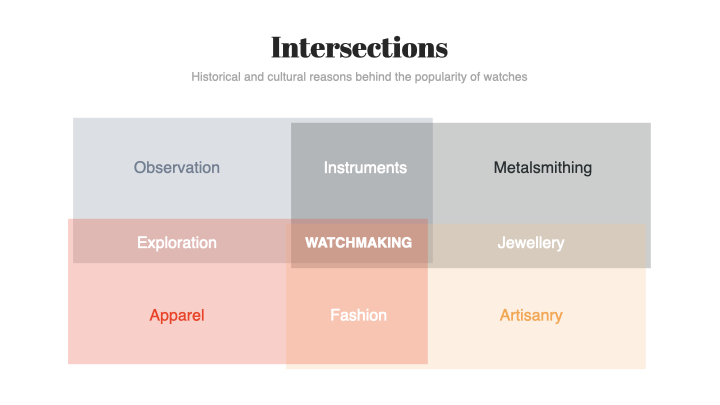In the second session of our WatchProjects MasterCourse, we discussed the positioning strategy of micro-brand owners in terms of identity and consumer buying behaviour.
Watchmaking is at the intersection of four major disciplines: observation, metalsmithing, artisanry and apparel, and their intersections have allowed for the creation of exporational, fashion, jewellery and instruments watches.
When it comes to buying behaviour, brands can position themselves based on the amount of involvement required from the customer and the amount of differentiation that they offer. Micro-brands managers have to ensure that they create sufficient differentiation to make their brand stand out, but the amount of customer involvement is not a dealbreaker.
Material reproduced under Fair Use / Fair Dealings:
- Montres Rolex SA
- Eikon Film & Neue Filmproduktion TV
- Thomas Brac de La Perrière (https://www.youtube.com/watch?v=TGGxJdg3Yx0&t=180s)
- Elliott Clock Repairs (https://www.youtube.com/watch?v=he17xuexoQU)
- Fashion Channel (https://www.youtube.com/watch?v=hwuE2HoVfYc)
- WatchGecko (https://www.youtube.com/watch?v=BwDKfyPbmv0)
- A. Lange & Söhne (https://www.youtube.com/watch?v=3i_gR0MKPGY)
- Woodshores AB (https://woodshores.agency/trends/2020/03/brand-equity-via-purchase-decision)
Exclusive content from the second session of our WatchProjects MasterCourse involves cost structure and suppliers suggestions.
We illustrate the 7 price tiers of Rambourg's Luxury Pyramid with a cost breakdown of components, and show how incumbent brands try to preserve a consistency between the quality of their respective components.
When it comes to suppliers, we have a list of suggestions per price tier based on nearly 15 years of field experience.
To access this type of exclusive content, become a supporter of the channel on Locals.
Source:
• Erwan Rambourg (https://www.wiley.com/en-us/The+Bling+Dynasty%3A+Why+the+Reign+of+Chinese+Luxury+Shoppers+Has+Only+Just+Begun-p-9781118950296)
In our first MasterCourse session, we discussed several topics pertaining to incumbent brands and micro-brands.
I describe the gradual "luxification" of products over the last two decades by incumbent brands, which created a void in the supply, that micro-brands are filling.
I offer a criterion for determining the difference between micro-brand, boutique brand and incumbent brand, and I provide estimates of the size of the micro-brand industry:
• The amount of new micro-brand launched in the last 10 years.
• The volume of watches put on the market by micro-brands on a yearly basis.
• The market value that micro-brands represent at the time of writing.
This is a small section of what was discussed during the MasterCourse session. For more, check our home page at blog.watchprojects.com.
Music by Bensound.
Topics covered in our second MasterCourse session were: Differentiation and purchase decision, cost structure and supplier shortlist.
In the second session of the MasterCourse, we went over the 4 disciplines that watchmaking finds itself at the intersection of: scientific observation, metalsmithing, artisanry and apparel.
This helps to understand why there are four distinct styles of watches: measuring instruments, exploration instruments (land, sea and air), jewellery watches and fashion timepieces.
When it comes to brand differentiation, we also covered a chart of Purchasing Habit model based on the research of Prof. Assael of NYU, and we saw how it can apply to watches.
These slides on "Purchase Decision and Cost Structure" are available on ISUU (https://wdsh.rs/bl), and you can read all about Assael's model of purchasing habit applied to watches in our article "Brand Equity via Purchase Decision" (https://wdsh.rs/bj).
So in the last 72h we've already got a nice group enlisting for our upcoming Spring 2023 MasterCourse (https://wdsh.rs/mastercourse).
Whether you are already working on your micro-brand, thinking about developing one, or simply curious about the ins and outs of the business, you can sign up for one of the free seats available.
Curated by a veteran with two decades of experience with five watchmaking groups, this MasterCourse is designed to provide you with the best frameworks from the industry.
(Photo by Anete Lusina)

According to How Money Works, "If someone is making a big deal about how easy it is to get into some type of business, or how you are guaranteed certain returns, that should not be a selling point: that should be a giant red flag. A business that's easy to get into means it's easy for your competition to get in too. More competition means less profits, and a greater risk of failure.
If you really want to go into business, you want to find something that is incredibly hard to get into, or better yet, find something that ONLY you can do."
That's why you need all the preparation you can get.














